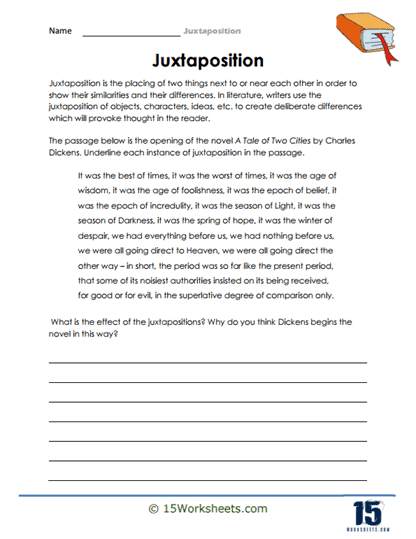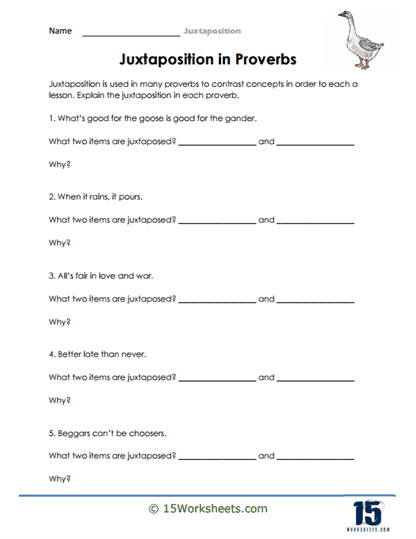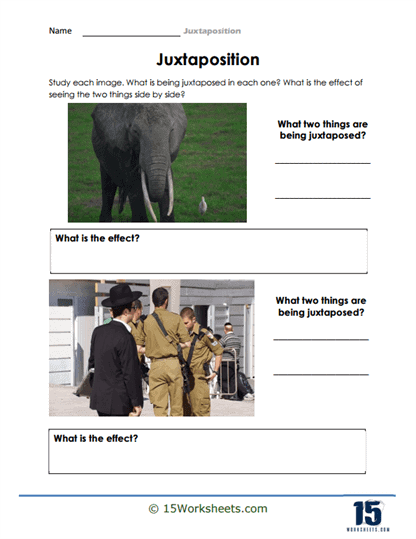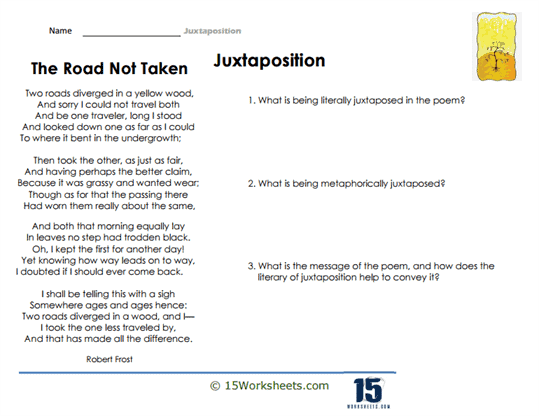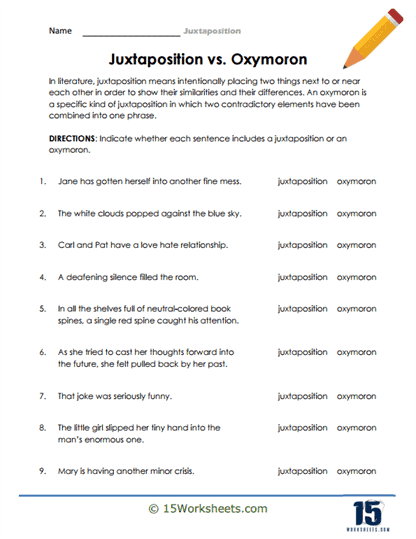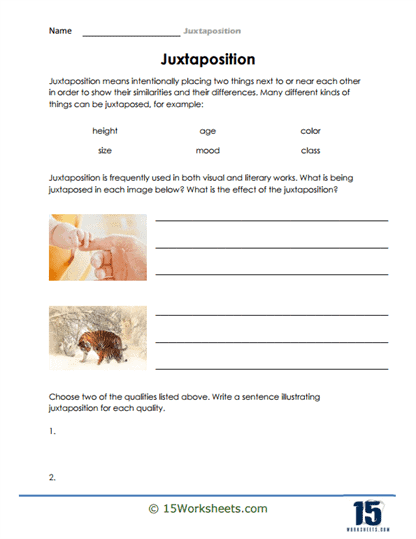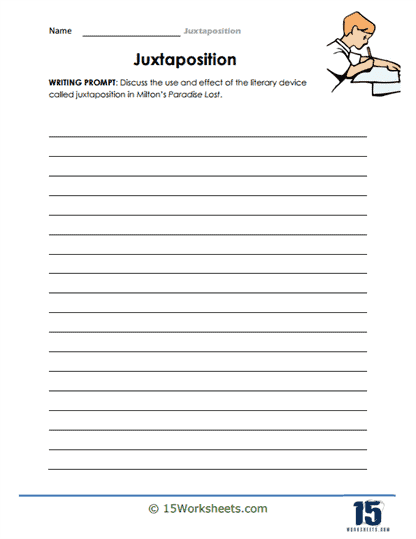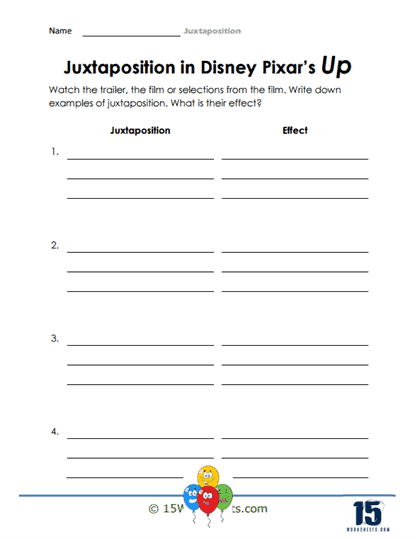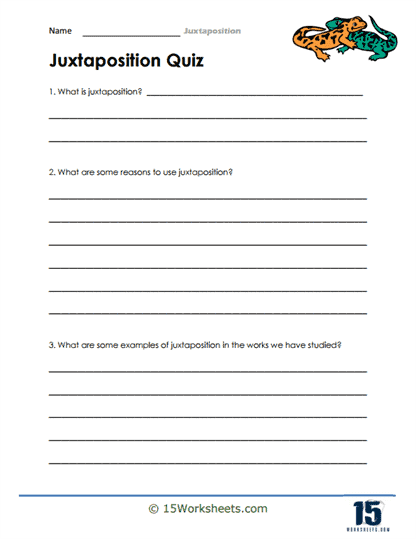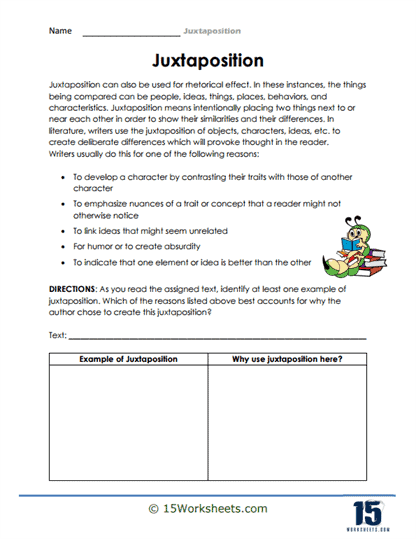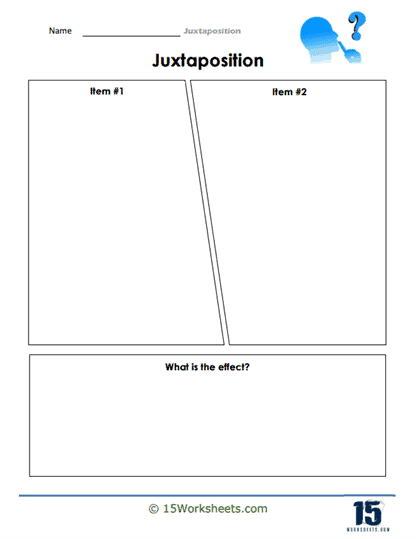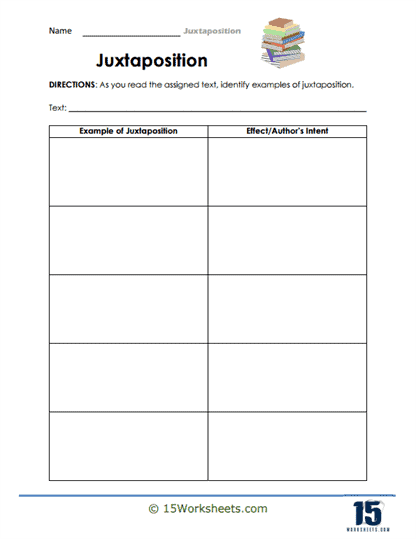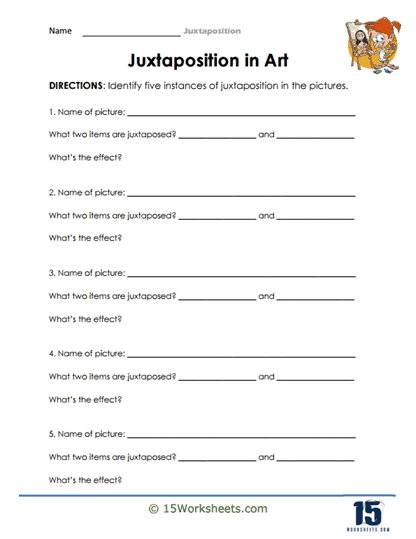Juxtaposition Worksheets
All About These 15 Worksheets
Juxtaposition, the placement of two contrasting elements side by side to highlight their differences or create a striking effect, is a powerful literary and artistic device. Understanding juxtaposition is crucial for students to appreciate the depth, complexity, and impact of language, art, and storytelling. This collection of 15 worksheets is designed to introduce students to the concept of juxtaposition, helping them understand its importance, recognize its usage in various mediums, and apply it creatively in their own writing and critical analysis.
These worksheets were developed to help students understand the literary device of juxtaposition. In literature, juxtaposition refers to placing two or more things side by side, often for the purpose of comparison or contrast. This technique can help to highlight differences or similarities and can be used to create a variety of effects, from irony to drama to humor.
Here are some examples of the types of exercises you might find on a juxtaposition worksheet:
Identification – A fundamental exercise could involve providing students with different passages of text and asking them to identify examples of juxtaposition. For instance, they could be given a section from a book where a wealthy neighborhood is directly compared to a poor one, or a scene where a character’s cheerful dialogue is set against a gloomy backdrop.
Analyzing – These exercises might involve a deeper analysis of a given passage. Students might be asked to write about why the author has chosen to juxtapose two particular elements and what this contrast or comparison reveals about the theme, character, or setting.
Creating Juxtaposition – In a more advanced or creative exercise, students could be asked to write their own paragraphs or short stories using juxtaposition. For example, they could be tasked with writing a story where a harsh winter setting contrasts with the warmth of a family gathering, and then discuss how this juxtaposition contributes to the mood or theme of their story.
Comparing Uses – In a more complex task, students could compare different examples of juxtaposition across multiple texts. They could be asked to analyze how different authors use this technique to different effects, such as to create humor, irony, or tension.
By completing these exercises on a juxtaposition worksheet, students can develop a deeper understanding of this literary device, learn how to identify and analyze it in the texts they read, and practice using it in their writing.
What is the Literary Device of Juxtaposition?
Juxtaposition is a versatile literary device that involves placing two or more elements side by side for the purpose of comparison or contrast. It can involve characters, settings, moods, themes, or any other aspects of a narrative, and its main function is to highlight contrasts or parallels in a way that illuminates key aspects of the text.
Defining Features of Juxtaposition
The core feature of juxtaposition is the deliberate contrast or comparison between two elements. By placing disparate or similar elements close together, authors can create striking images, illuminate hidden similarities or differences, or generate dramatic tension or irony. It allows readers to see things in a new light, deepens their understanding of the characters or the story, and adds complexity to the narrative.
Examples of Juxtaposition in Literature
“A Tale of Two Cities” by Charles Dickens
Dickens’ famous opening lines in “A Tale of Two Cities” is a classic example of juxtaposition – “It was the best of times, it was the worst of times, it was the age of wisdom, it was the age of foolishness, it was the epoch of belief, it was the epoch of incredulity.”
Here, Dickens juxtaposes opposing conditions of life during the French Revolution. This serves to encapsulate the paradoxes of the era, illustrating how people could simultaneously experience joy and despair, wisdom and folly. This juxtaposition helps to set the tone for the book and provides a sense of the turmoil and contradictions of the time.
“Romeo and Juliet” by William Shakespeare
In “Romeo and Juliet,” Shakespeare frequently uses juxtaposition to enhance the themes of the play. For example, the peacefulness of Romeo and Juliet’s love is often juxtaposed against the violent feud between their families.
A more specific instance is when Romeo describes Juliet in Act 2, Scene 2 – “It is the east, and Juliet is the sun.” Here, Romeo juxtaposes Juliet, a young girl, with the sun, a celestial body. This not only emphasizes Juliet’s importance in Romeo’s eyes but also highlights the warmth and light she brings into his life amidst the surrounding darkness of their families’ conflict.
“To Kill a Mockingbird” by Harper Lee
In “To Kill a Mockingbird,” Lee uses juxtaposition to underline the theme of innocence and morality. The most significant example is the contrast between the two main “mockingbirds” – Tom Robinson, an innocent man wrongfully accused, and Boo Radley, a kind man feared due to his reclusive nature. The innocence and goodness of these characters are juxtaposed with the prejudice and corruption of the society they live in. This juxtaposition underscores the novel’s moral messages about justice, empathy, and the loss of innocence.
Juxtaposition is a powerful tool for authors, allowing them to highlight contrasts and parallels, deepen character development, enhance thematic elements, and create dramatic tension or irony. In the examples provided, we see how juxtaposition can set the tone for a narrative, highlight the nature of a character, or underscore a novel’s central themes.
The Importance Of Learning Juxtaposition For Students
Exploring the world of juxtaposition through this collection of 15 thought-provoking worksheets offers students an opportunity to develop essential skills in literary appreciation, artistic sensibility, critical thinking, media literacy, and creative expression. Juxtaposition is a versatile tool that enriches various forms of communication, from literature and art to advertising and film.
By engaging with these exercises and activities, students not only enhance their academic abilities but also gain valuable tools for creative expression, critical analysis, and media literacy. The benefits of studying juxtaposition extend far beyond the classroom, empowering students to be more discerning consumers and creators of content in an increasingly visually and linguistically complex world.

